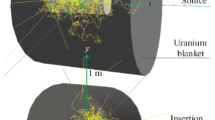Abstract
Radioactive nuclides will be produced in structures and surrounding materials of the relativistic heavy ion collider NICA. Predicting radioactivity in the materials, air, cooling water, and ground is an important part of the technical project. Some Monte Carlo transport codes (FLUKA, GEANT4, SHIELD) can simulate the production of radionuclides induced by heavy ions. The preliminary verification of MC codes with experimental data is necessary before using them for radiation protection purposes. In the present work, comparisons of the experiment and GEANT4 and SHIELD simulations of induced activity in thick stainless steel and copper targets irradiated with 950 MeV/nucleon uranium ions are presented.
Similar content being viewed by others
References
I. Strašík et al., “Experimental Study of the Residual Activity Induced by 950 MeV/u Uranium Ions in Stainless Steel and Copper,” Nucl. Instrum. Methods Phys. Res. B 266, 3443–3452 (2008).
G. Battistoni et al., “The FLUKA Code: Description and Benchmarking,” in Proceedings of the Hadronic Shower Simulation Workshop, Fermilab, 2006, Ed. by M. Albrow and R. Raja, AIP Conf. Proc. 896, 31–49 (2007).
A. Fasso et al., “FLUKA: A Multi-Particle Transport Code,” CERN-2005-10 (2005), INFN/TC-05/11, SLAC-R-773.
E. Kozlova et al., “Benchmark Study of Induced Radioactivity with Heavy Ions on Copper and Stainless Steel Targets,” in ARIA 2008, Proceedings of the 1st Workshop on Accelerator Radiation Induced Activation (Paul Scherrer Inst., Switzerland, 2008).
J. Allison et al., “Geant4 Developments and Applications,” IEEE Trans. Nucl. Sci. 53, 270–278 (2006).
S. Agostinelli et al., “Geant4 — A Simulation Toolkit,” Nucl. Instrum. Methods Phys. Res. A 506, 250–303 (2003).
N. M. Sobolevsky, The SHIELD Code, (Version 1996.hadr.0), Short User’s Manual Informal Report (1998).
A. V. Dementyev and N. M. Sobolevsky, “SHIELD, a Monte Carlo Hadron Transport Code,” in Proceedings of a Specialists’ Meeting on Intermediate Energy Nuclear Data: Models and Codes (Issy-les-Moulineaux, France, 1994), pp. 237–258.
Yu. N. Shubin et al., “Cross-Section Data Library MENDL-2 to Study Activation as Transmutation of Materials Irradiated by Nucleons of Intermediate Energies,” Report INDC(CCP)-385 (Int. At. Energy Agency, 1995).
K. Tasaka, “DCHAIN2: A Computer Code for Calculation of Transmutation of Nuclides,” JAERI-M-8727 (1980).
Author information
Authors and Affiliations
Corresponding author
Additional information
The article is published in the original.
Rights and permissions
About this article
Cite this article
Beskrovnaia, L., Latysheva, L., Paraipan, M. et al. Simulation of residual activity in steel and copper targets induced by 950 MeV/nucleon uranium ions. Phys. Part. Nuclei Lett. 8, 364–367 (2011). https://doi.org/10.1134/S1547477111040042
Published:
Issue Date:
DOI: https://doi.org/10.1134/S1547477111040042




